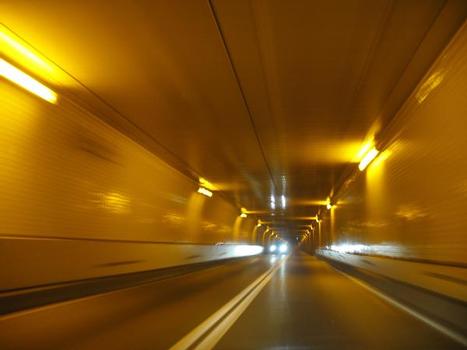General Information
Project Type
| Structure: |
Tunnel |
|---|---|
| Function / usage: |
Road tunnel |
Location
| Location: |
Baltimore, Maryland, USA |
|---|---|
| For: |
|
| Coordinates: | 39° 15' 51.80" N 76° 33' 47.07" W |
| Coordinates: | 39° 14' 45.05" N 76° 34' 36.20" W |
Technical Information
Dimensions
| tunnel length | 2 332 m | |
| number of lanes | 4 |
Cost
| cost of construction | United States dollar 130 000 000 |
Materials
| tunnel structure |
precast concrete
reinforced concrete |
|---|
Chronology
| January 1955 | Construction begins. |
|---|---|
| 29 November 1957 | Opens to traffic. |
Excerpt from Wikipedia
The Baltimore Harbor Tunnel is a pair of two-lane road tunnels carrying Interstate 895—the Harbor Tunnel Thruway—under the Patapsco River southeast of downtown Baltimore, Maryland, United States.
Description
The pair of tunnels is 1.45 mi. (7,650 feet (2.33 km)) long, stretching from the south shore of the Patapsco River to the north shore near Dundalk. Each tunnel is 22 feet (6.7 m) wide and 14 feet (4.3 m) high, and accommodates two lanes in each direction. The maximum speed within the tunnel is 50 miles per hour (80 km/h).
Both portals have ventilation buildings, with a total of 32 fans in place to replace the air within the tunnels, which is drawn in through the tunnel floors and exhausted through the tunnel ceilings. The tubes themselves range from a depth of 50 feet (15.2 m) below ground to 101 feet (30.8 m) below ground.
As of July 1, 2015, the toll rate for cars is $4.00 cash or $3.00 E-ZPass, paid in either direction. Vehicles with more than two axles pay additional amounts, up to $30.00 for six axles.
History
The tunnel and approaches were designed by Singstad and Baillie, a New York-based engineering firm specializing in tunnel design, in association with the J. E. Greiner Company, a local Baltimore-based firm. The tunnel was formed out of twenty-one 310-foot (94 m) sections individually submerged into the harbor and secured with rocks and backfill; the first of these tunnel segments was sunk on April 11, 1956. The remainder of the tunnel was constructed using the cut-and-cover method, extending from the submerged tubes to the north and south portals.
The tunnel opened on November 29, 1957 (along with most of the Thruway), nearly two months ahead of schedule. At the time, the toll was forty cents. The day the tunnel was opened, it experienced heavy traffic for the first time as thousands of motorists traveled north to Philadelphia to watch the 1957 Army–Navy football game.
Shortly after the nearby Fort McHenry Tunnel opened in 1985 — making up the final link of Interstate 95 in Maryland — the Harbor Tunnel was closed in phases for extensive rehabilitation. It was fully reopened by 1990.
In November, 2007, the 50th anniversary of the tunnel serving travelers was observed.
Text imported from Wikipedia article "Baltimore Harbor Tunnel" and modified on July 22, 2019 according to the CC-BY-SA 4.0 International license.
Participants
Relevant Web Sites
- About this
data sheet - Structure-ID
20002475 - Published on:
04/12/2001 - Last updated on:
28/05/2021





